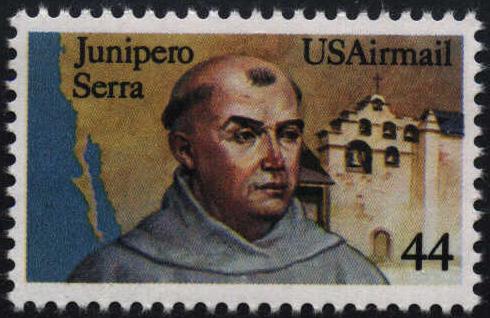I learnt a lot from another current exhibition at the Huntington, about the man sometimes called the ‘founding father of California’. ‘Junipero Serra and the Legacies of the California Missions’ coincides with the 300th anniversary of the birth of the Franciscan priest who journeyed in the mid-1700s from the Spanish island of Mallorca to Mexico, and then up to California, where he established a series of missions for the conversion of the native Indians to the Catholic faith.
Curated by Steven Hackel and Catherine Gudis, this tremendous exhibition paints a very complex picture of the relationships between the region’s diverse Indian communities and the Franciscans who ran the missions throughout the eighteenth century and beyond.
Many of the 250+ artefacts (from the Huntington’s collections, and loaned from an impressive number of other places as well) in the exhibition were intriguing material texts – some of the numerous letters Serra wrote to fellow priests in Mexico, and to his family back in Spain; a woodblock supposedly used by Serra to print religious sheets for distribution in the streets; rare surviving written examples of a few of the more than one hundred languages spoken by the Indian communities. One of the really striking things was the bureaucratic efficiency of the Franciscans in charge of the missions, who documented every baptism, marriage, and burial. As the curators are careful to point out, these records would have been for Serra and his colleagues a glorious accounting of souls saved, but they can also be read as a terrible toll of mission life on Californian communities: disease, for example, brought untimely death to thousands of Indians. The surviving records have been collated in the Early California Population Project.
All Californian schoolchildren learn about Junipero Serra today, and this remarkable exhibition attempts to complicate some of the traditional narratives around this figure, emphasising the rich range of responses of the Indians to the missionaries. The curators also stress the ways in which both the Indian and Spanish pasts have been romanticised – through the ‘mission revival’ architectural fashions of the nineteenth and twentieth centuries, and the evolution of the missions into tourist attractions, for example. Another material text chosen for the exhibition speaks of this tendency to mythologise California’s complex past: in 1967, Ronald Reagan was sworn into office as Governor of the state with a bible thought (though nobody can be sure) to have been used by Serra.
The exhibition continues until 6th January 2014, and is definitely worth a visit if you’re in the area.
